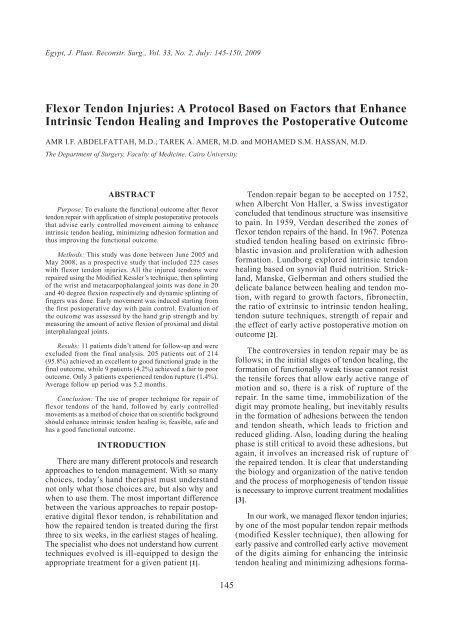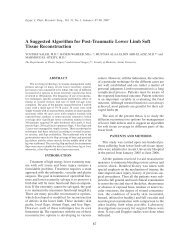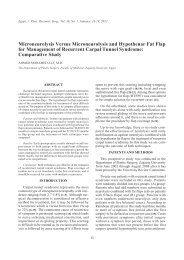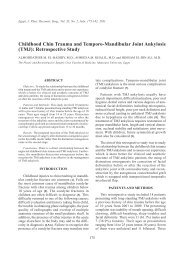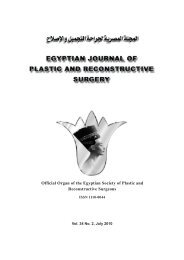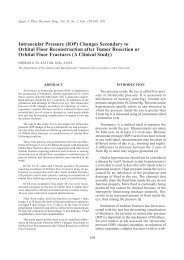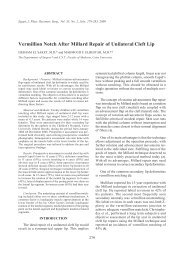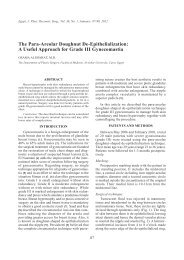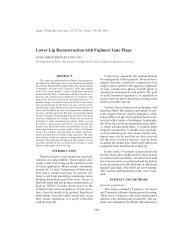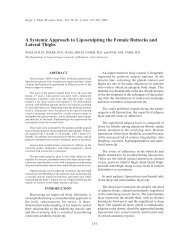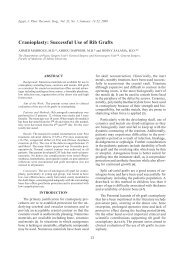Flexor Tendon Injuries: A Protocol Based on Factors that ... - ESPRS
Flexor Tendon Injuries: A Protocol Based on Factors that ... - ESPRS
Flexor Tendon Injuries: A Protocol Based on Factors that ... - ESPRS
Create successful ePaper yourself
Turn your PDF publications into a flip-book with our unique Google optimized e-Paper software.
Egypt, J. Plast. Rec<strong>on</strong>str. Surg., Vol. 33, No. 2, July: 145-150, 2009<br />
<str<strong>on</strong>g>Flexor</str<strong>on</strong>g> <str<strong>on</strong>g>Tend<strong>on</strong></str<strong>on</strong>g> <str<strong>on</strong>g>Injuries</str<strong>on</strong>g>: A <str<strong>on</strong>g>Protocol</str<strong>on</strong>g> <str<strong>on</strong>g>Based</str<strong>on</strong>g> <strong>on</strong> <strong>Factors</strong> <strong>that</strong> Enhance<br />
Intrinsic <str<strong>on</strong>g>Tend<strong>on</strong></str<strong>on</strong>g> Healing and Improves the Postoperative Outcome<br />
AMR I.F. ABDELFATTAH, M.D.; TAREK A. AMER, M.D. and MOHAMED S.M. HASSAN, M.D.<br />
The Department of Surgery, Faculty of Medicine, Cairo University.<br />
ABSTRACT<br />
Purpose: To evaluate the functi<strong>on</strong>al outcome after flexor<br />
tend<strong>on</strong> repair with applicati<strong>on</strong> of simple postoperative protocols<br />
<strong>that</strong> advise early c<strong>on</strong>trolled movement aiming to enhance<br />
intrinsic tend<strong>on</strong> healing, minimizing adhesi<strong>on</strong> formati<strong>on</strong> and<br />
thus improving the functi<strong>on</strong>al outcome.<br />
Methods: This study was d<strong>on</strong>e between June 2005 and<br />
May 2008, as a prospective study <strong>that</strong> included 225 cases<br />
with flexor tend<strong>on</strong> injuries. All the injured tend<strong>on</strong>s were<br />
repaired using the Modified Kessler’s technique, then splinting<br />
of the wrist and metacarpophalangeal joints was d<strong>on</strong>e in 20<br />
and 40 degree flexi<strong>on</strong> respectively and dynamic splinting of<br />
fingers was d<strong>on</strong>e. Early movement was induced starting from<br />
the first postoperative day with pain c<strong>on</strong>trol. Evaluati<strong>on</strong> of<br />
the outcome was assessed by the hand grip strength and by<br />
measuring the amount of active flexi<strong>on</strong> of proximal and distal<br />
interphalangeal joints.<br />
Results: 11 patients didn’t attend for follow-up and were<br />
excluded from the final analysis. 205 patients out of 214<br />
(95.8%) achieved an excellent to good functi<strong>on</strong>al grade in the<br />
final outcome, while 9 patients (4.2%) achieved a fair to poor<br />
outcome. Only 3 patients experienced tend<strong>on</strong> rupture (1.4%).<br />
Average follow up period was 5.2 m<strong>on</strong>ths.<br />
C<strong>on</strong>clusi<strong>on</strong>: The use of proper technique for repair of<br />
flexor tend<strong>on</strong>s of the hand, followed by early c<strong>on</strong>trolled<br />
movements as a method of choice <strong>that</strong> <strong>on</strong> scientific background<br />
should enhance intrinsic tend<strong>on</strong> healing is; feasible, safe and<br />
has a good functi<strong>on</strong>al outcome.<br />
INTRODUCTION<br />
There are many different protocols and research<br />
approaches to tend<strong>on</strong> management. With so many<br />
choices, today’s hand therapist must understand<br />
not <strong>on</strong>ly what those choices are, but also why and<br />
when to use them. The most important difference<br />
between the various approaches to repair postoperative<br />
digital flexor tend<strong>on</strong>, is rehabilitati<strong>on</strong> and<br />
how the repaired tend<strong>on</strong> is treated during the first<br />
three to six weeks, in the earliest stages of healing.<br />
The specialist who does not understand how current<br />
techniques evolved is ill-equipped to design the<br />
appropriate treatment for a given patient [1].<br />
145<br />
<str<strong>on</strong>g>Tend<strong>on</strong></str<strong>on</strong>g> repair began to be accepted <strong>on</strong> 1752,<br />
when Albercht V<strong>on</strong> Haller, a Swiss investigator<br />
c<strong>on</strong>cluded <strong>that</strong> tendinous structure was insensitive<br />
to pain. In 1959, Verdan described the z<strong>on</strong>es of<br />
flexor tend<strong>on</strong> repairs of the hand. In 1967. Potenza<br />
studied tend<strong>on</strong> healing based <strong>on</strong> extrinsic fibroblastic<br />
invasi<strong>on</strong> and proliferati<strong>on</strong> with adhesi<strong>on</strong><br />
formati<strong>on</strong>. Lundborg explored intrinsic tend<strong>on</strong><br />
healing based <strong>on</strong> synovial fluid nutriti<strong>on</strong>. Strickland,<br />
Manske, Gelberman and others studied the<br />
delicate balance between healing and tend<strong>on</strong> moti<strong>on</strong>,<br />
with regard to growth factors, fibr<strong>on</strong>ectin,<br />
the ratio of extrinsic to intrinsic tend<strong>on</strong> healing,<br />
tend<strong>on</strong> suture techniques, strength of repair and<br />
the effect of early active postoperative moti<strong>on</strong> <strong>on</strong><br />
outcome [2].<br />
The c<strong>on</strong>troversies in tend<strong>on</strong> repair may be as<br />
follows; in the initial stages of tend<strong>on</strong> healing, the<br />
formati<strong>on</strong> of functi<strong>on</strong>ally weak tissue cannot resist<br />
the tensile forces <strong>that</strong> allow early active range of<br />
moti<strong>on</strong> and so, there is a risk of rupture of the<br />
repair. In the same time, immobilizati<strong>on</strong> of the<br />
digit may promote healing, but inevitably results<br />
in the formati<strong>on</strong> of adhesi<strong>on</strong>s between the tend<strong>on</strong><br />
and tend<strong>on</strong> sheath, which leads to fricti<strong>on</strong> and<br />
reduced gliding. Also, loading during the healing<br />
phase is still critical to avoid these adhesi<strong>on</strong>s, but<br />
again, it involves an increased risk of rupture of<br />
the repaired tend<strong>on</strong>. It is clear <strong>that</strong> understanding<br />
the biology and organizati<strong>on</strong> of the native tend<strong>on</strong><br />
and the process of morphogenesis of tend<strong>on</strong> tissue<br />
is necessary to improve current treatment modalities<br />
[3].<br />
In our work, we managed flexor tend<strong>on</strong> injuries;<br />
by <strong>on</strong>e of the most popular tend<strong>on</strong> repair methods<br />
(modified Kessler technique), then allowing for<br />
early passive and c<strong>on</strong>trolled early active movement<br />
of the digits aiming for enhancing the intrinsic<br />
tend<strong>on</strong> healing and minimizing adhesi<strong>on</strong>s forma-
146 Vol. 33, No. 2 / <str<strong>on</strong>g>Flexor</str<strong>on</strong>g> <str<strong>on</strong>g>Tend<strong>on</strong></str<strong>on</strong>g> <str<strong>on</strong>g>Injuries</str<strong>on</strong>g><br />
ti<strong>on</strong>, thus giving the best chance for an excellent<br />
functi<strong>on</strong>al recovery for the repaired tend<strong>on</strong>s.<br />
<str<strong>on</strong>g>Flexor</str<strong>on</strong>g> tend<strong>on</strong> anatomy:<br />
The flexor tend<strong>on</strong>s of the wrist, flexor carpi<br />
radialis (FCR) and flexor carpi ulnaris (FCU) are<br />
str<strong>on</strong>g and thick tend<strong>on</strong>s, while the flexor pollicis<br />
l<strong>on</strong>gus (FPL) has a distal muscle belly. The flexor<br />
tend<strong>on</strong>s of the fingers are arranged into three layers;<br />
flexor digitorum supericialis (FDS) tend<strong>on</strong>s of the<br />
middle and ring fingers are most superficial; superficialis<br />
tend<strong>on</strong>s of the index and little fingers<br />
are in the middle, while the deepest layer is composed<br />
of the FPL and the four tend<strong>on</strong>s of the flexor<br />
digitorum profundi (FDP). There is often a tend<strong>on</strong><br />
slip from the FDP of the index to the FPL, which<br />
may require excisi<strong>on</strong> to prevent post-surgical complicati<strong>on</strong>s<br />
[4,5].<br />
Clinical tend<strong>on</strong> z<strong>on</strong>es of verdan:<br />
These z<strong>on</strong>es are used to describe flexor tend<strong>on</strong><br />
injuries of the hand and wrist:<br />
• Z<strong>on</strong>e I: Extends from the finger tip to the midporti<strong>on</strong><br />
of the middle phalanx (the Green Z<strong>on</strong>e).<br />
• Z<strong>on</strong>e II: Extends from the midporti<strong>on</strong> of the<br />
middle phalanx to the distal palmar crease (No-<br />
Man’s Land or the Red Z<strong>on</strong>e).<br />
• Z<strong>on</strong>e III: Extends from the distal crease to the<br />
distal porti<strong>on</strong> of the transverse carpal ligament.<br />
• Z<strong>on</strong>e IV: Overlies the transverse carpal ligament<br />
(carpal tunnel).<br />
• Z<strong>on</strong>e V: Extends from the wrist crease to the<br />
level of the musculotendinous juncti<strong>on</strong> of the<br />
flexor tend<strong>on</strong>s. Z<strong>on</strong>es III, IV and V c<strong>on</strong>stitute<br />
the Yellow Z<strong>on</strong>e [6].<br />
Pulleys’ system:<br />
Pulleys are thickening al<strong>on</strong>g flexor sheaths<br />
lined with synovium. They improve biomechanics<br />
of flexor tend<strong>on</strong>s by preventing bowstringing of<br />
tend<strong>on</strong>s during flexi<strong>on</strong>. Fingers have 5 annular<br />
pulleys and 3 cruciate pulleys. Annular pulleys are<br />
A1 at metacarpophalangeal joint (MPJ), A2 over<br />
the proximal phalanx, A3 at the proximal interphalangeal<br />
joint (PIPJ), A4 over middle phalanx and<br />
A5 at the distal interphalangeal joint (DIPJ). A2<br />
and A4 are the most important to prevent bowstringing.<br />
Cruciate pulleys are between the annular<br />
pulleys, they are thinner and less biomechanically<br />
important than annular pulleys. The thumb has 2<br />
annular pulleys; A1 at MPJ, A2 at interphalangeal<br />
joint, and <strong>on</strong>e oblique pulley, which is an extensi<strong>on</strong><br />
of adductor pollicis attachment <strong>that</strong> lies between<br />
A1 and A2 and it is the most important thumb<br />
pulley to prevent bowstringing [7].<br />
Nutriti<strong>on</strong> of flexor tend<strong>on</strong>s:<br />
<str<strong>on</strong>g>Tend<strong>on</strong></str<strong>on</strong>g>s have two sources of nutriti<strong>on</strong>, an internal<br />
source provided by vascular perfusi<strong>on</strong> and<br />
external source provided by synovial fluid [6].<br />
<str<strong>on</strong>g>Tend<strong>on</strong></str<strong>on</strong>g>s without synovial sheath receive blood<br />
supply from l<strong>on</strong>gitudinal anastomotic capillary<br />
system, <strong>that</strong> receive segmental blood supply from;<br />
Vessels in the perimysium and vessels at the b<strong>on</strong>y<br />
inserti<strong>on</strong>s.<br />
The source of nutrients for the flexor tend<strong>on</strong>s<br />
with synovial sheath is either; vascular perfusi<strong>on</strong><br />
and synovial fluid diffusi<strong>on</strong>. The segmental blood<br />
supply of the tend<strong>on</strong>s is from vessels from muscular<br />
branches in the forearm, vessels in the surrounding<br />
c<strong>on</strong>nective tissue via the mesoten<strong>on</strong> c<strong>on</strong>duit ''vincula'',<br />
vessels from the b<strong>on</strong>e, at the inserti<strong>on</strong> and<br />
vessels from periosteum near inserti<strong>on</strong> [8].<br />
In the last decades, many studies of synovial<br />
perfusi<strong>on</strong> of the flexor tend<strong>on</strong>s within the synovial<br />
sheath have been d<strong>on</strong>e [9]. Studies dem<strong>on</strong>strate<br />
<strong>that</strong> synovial fluid perfusi<strong>on</strong> was more effective<br />
than vascular perfusi<strong>on</strong>, indeed when the tend<strong>on</strong><br />
was isolated from its vascular c<strong>on</strong>necti<strong>on</strong>s, diffusi<strong>on</strong><br />
could provide the total nutriti<strong>on</strong> requirements to<br />
all segments. Synovial diffusi<strong>on</strong> also c<strong>on</strong>tributes<br />
in tend<strong>on</strong> healing as the l<strong>on</strong>gitudinal tend<strong>on</strong> vasculature<br />
may be easily occluded by sutures, thus<br />
sheath repair or rec<strong>on</strong>structi<strong>on</strong> is indicated.<br />
<str<strong>on</strong>g>Tend<strong>on</strong></str<strong>on</strong>g> healing:<br />
Three phases of tend<strong>on</strong> healing are present;<br />
Inflammatory phase (first week), Proliferative<br />
phase (2 nd-4r th week) and Remodeling phase (2 nd-<br />
6 th m<strong>on</strong>th). <str<strong>on</strong>g>Tend<strong>on</strong></str<strong>on</strong>g>s exhibit two types of healing,<br />
with different ratios. Extrinsic healing: Fibroblasts<br />
migrate from the sheath into the injured site and<br />
also from adhesi<strong>on</strong>. This type of healing is enhanced<br />
by postoperative immobilizati<strong>on</strong> [7]. This explains<br />
why immobilizati<strong>on</strong> protocols to restore tend<strong>on</strong><br />
c<strong>on</strong>gruity result in scar formati<strong>on</strong> at the repair site,<br />
rather than a linear fibrous array and peripheral<br />
adhesi<strong>on</strong>s <strong>that</strong> limit tend<strong>on</strong> movements [10]. Intrinsic<br />
healing: <str<strong>on</strong>g>Tend<strong>on</strong></str<strong>on</strong>g> cells can migrate across closely<br />
approximated ends and heal with nutrients from<br />
synovial fluid. Peripheral adhesi<strong>on</strong>s do not participate<br />
in intrinsic tend<strong>on</strong> healing. Although some<br />
authors believed <strong>that</strong> adhesi<strong>on</strong>s formati<strong>on</strong> is essential<br />
in tend<strong>on</strong> healing, several studies dem<strong>on</strong>strated<br />
the intrinsic ability of flexor tend<strong>on</strong>s to heal via<br />
nutrients supplied by diffusi<strong>on</strong> from the synovial<br />
fluid [11].
Egypt, J. Plast. Rec<strong>on</strong>str. Surg., July 2009 147<br />
PATIENTS AND METHODS<br />
This prospective study was performed in the<br />
Emergency Unit, Kasr Al-Aini Hospital (Faculty<br />
of Medicine, Cairo University) in the period between<br />
6/2005 and 5/2008. Table (1) shows the<br />
demography of the included patients. The number<br />
of cases included was 225 cases suffering from<br />
flexor tend<strong>on</strong> injuries in z<strong>on</strong>es I, II, III, IV and V,<br />
but eleven cases were excluded from the final<br />
analysis as they were not present during the followup<br />
period (Table 2). Included cases were cases<br />
with flexor tend<strong>on</strong> injuries presenting within less<br />
than 24 hours from the injury. Exclusi<strong>on</strong> criteria<br />
were; children below 12 years for expected bad<br />
compliance, late presentati<strong>on</strong>, infected, c<strong>on</strong>tused<br />
and crushed wounds and shocked poly-trauma<br />
patients.<br />
Table (1): Demographic distributi<strong>on</strong> of patients.<br />
Number of patients<br />
Sex (Male & Female respectively)<br />
Age in years<br />
Manual Workers<br />
Table (2): Distributi<strong>on</strong> according to z<strong>on</strong>e injuries.<br />
Z<strong>on</strong>e I injury<br />
Z<strong>on</strong>e II injury<br />
Z<strong>on</strong>e III injury<br />
Z<strong>on</strong>e IV injury<br />
Z<strong>on</strong>e V injury<br />
Total<br />
33 (15%)<br />
48 (22%)<br />
36 (17%)<br />
38 (18%)<br />
59 (28%)<br />
214<br />
214<br />
153 (75%) & 61 (25%)<br />
Between 12 & 63 years<br />
122 (60%)<br />
First aid was d<strong>on</strong>e for every case, including<br />
ensuring of adequate general status of the patients<br />
(airway, breathing, circulati<strong>on</strong>), followed by IV<br />
analgesia, IV antibiotics (single dose of 3 rd generati<strong>on</strong><br />
cephalosporine), booster dose of antitetanic<br />
toxoid was administrated. Clinical assessment of<br />
the hand injury (vascularity, diagnosis of injured<br />
tend<strong>on</strong>s and associated injures). The wound was<br />
washed by sterile saline, bovid<strong>on</strong>e iodine, IV<br />
explored under either general anaesthesia or IV<br />
Bier’s block and a pneumatic tourniquet was essential<br />
part in all cases (with m<strong>on</strong>itoring of the<br />
tourniquet time). Minimal handling of the tend<strong>on</strong>s<br />
was intenti<strong>on</strong>ally d<strong>on</strong>e. <str<strong>on</strong>g>Tend<strong>on</strong></str<strong>on</strong>g>s were repaired by<br />
core sutures by modified Kessler’s technique using<br />
4-0 polypropylene sutures and peripheral sutures.<br />
The wrist was splinted in 20 degree of flexi<strong>on</strong> and<br />
metacarpophalangeal joint at 40 degree of flexi<strong>on</strong>.<br />
Dynamic splint was applied to the fingers using<br />
elastics. Early passive and active movements were<br />
d<strong>on</strong>e with the c<strong>on</strong>trol of pain. Movements started<br />
from the first postoperative day, hourly, for ten<br />
repetiti<strong>on</strong>s of active extensi<strong>on</strong> and flexi<strong>on</strong> of fingers<br />
while the hand is in the splinted positi<strong>on</strong>, and<br />
passively the DIPJ is then fully flexed. Therapeutic<br />
ultrasound was applied for 19 cases to enhance<br />
intrinsic healing. Follow-up was d<strong>on</strong>e twice weekly<br />
for <strong>on</strong>e m<strong>on</strong>th and then weekly for two m<strong>on</strong>ths,<br />
then every m<strong>on</strong>th. Follow-up ranged between 6<br />
m<strong>on</strong>ths and 18 m<strong>on</strong>ths.<br />
RESULTS<br />
From the 225 patients, 11 patients didn’t attend<br />
the follow-up period and were excluded from the<br />
final analysis. All the included patients c<strong>on</strong>tinued<br />
with the follow-up for at least 3 m<strong>on</strong>ths, while<br />
<strong>on</strong>ly 193 completed a period of follow-up of 6<br />
m<strong>on</strong>ths. So, the final analysis was based <strong>on</strong> results<br />
recorded after 3 m<strong>on</strong>ths of follow-up. Average<br />
follow-up period was 5.2 m<strong>on</strong>ths.<br />
Evaluati<strong>on</strong> of the outcome was based up<strong>on</strong><br />
hand functi<strong>on</strong> and this is the important issue in<br />
tend<strong>on</strong> repair and also it is impossible to assess<br />
the amount of intrinsic healing to the amount of<br />
intrinsic healing in a living human. So, the results<br />
of the repair were assessed by clinical evaluati<strong>on</strong><br />
of tend<strong>on</strong>s’ functi<strong>on</strong>.<br />
This was d<strong>on</strong>e by assessing the hand grip<br />
strength and by testing for the amount of active<br />
flexi<strong>on</strong> of the distal interphalangeal joints and<br />
proximal interphalangeal joints, then subtracting<br />
the amount of active extensi<strong>on</strong> deficit at these<br />
joints during active extensi<strong>on</strong>. The results were<br />
graded as A: Excellent (>132 degree total moti<strong>on</strong>),<br />
B: Good (88- 131 degree), C: Fair (44- 87 degree),<br />
and D: Poor (
148 Vol. 33, No. 2 / <str<strong>on</strong>g>Flexor</str<strong>on</strong>g> <str<strong>on</strong>g>Tend<strong>on</strong></str<strong>on</strong>g> <str<strong>on</strong>g>Injuries</str<strong>on</strong>g><br />
of z<strong>on</strong>e III injury had either grade A or B functi<strong>on</strong>al<br />
outcome. Minor complicati<strong>on</strong>s related to the skin<br />
wound and <strong>that</strong> did not affect the final outcome<br />
occurred in 12 patients (5.6%), <strong>that</strong>’s including<br />
mild wound infecti<strong>on</strong> <strong>that</strong> was self-c<strong>on</strong>trolled,<br />
hematoma <strong>that</strong> may have required aspirati<strong>on</strong>,<br />
hypertrophic scar in which silic<strong>on</strong> patch was applied<br />
and an adherent scar occurred in single patient.<br />
Total failure of the repair occurred <strong>on</strong>ly in 3 patients,<br />
who experienced tend<strong>on</strong> rupture (1.4%) and<br />
require re-suturing (two cases in z<strong>on</strong>e II and <strong>on</strong>e<br />
case in z<strong>on</strong>e I and final outcome of such cases was<br />
added to the previous results).<br />
Table (3): Final outcome according to the injured z<strong>on</strong>e.<br />
Injured z<strong>on</strong>e<br />
Z<strong>on</strong>e I (Green)<br />
Z<strong>on</strong>e II (Red)<br />
Z<strong>on</strong>e III (Yellow)<br />
Z<strong>on</strong>e IV (Yellow)<br />
Z<strong>on</strong>e V (Yellow)<br />
Total<br />
Total<br />
number<br />
33 (14%)<br />
48 (23%)<br />
36 (17%)<br />
38 (18%)<br />
59 (28%)<br />
214 (100%)<br />
DISCUSSION<br />
Excellent-<br />
Good<br />
outcome<br />
31 (93.9%)<br />
44 (92.7%)<br />
36 (100%)<br />
37 (97.4%)<br />
57 (96.6%)<br />
205 (95.8%)<br />
Fairpoor<br />
outcome<br />
2 (6.1%)<br />
4 (8.3%)<br />
–<br />
1 (2.6%)<br />
2 (3.4%)<br />
9 (4.2%)<br />
Treatment of tend<strong>on</strong> injuries is an important<br />
part of hand surgery practice worldwide. Adhesi<strong>on</strong><br />
formati<strong>on</strong>, rupture of the repairs, stiffness of finger<br />
joints, remain the principal problems of primary<br />
tend<strong>on</strong> repairs. <str<strong>on</strong>g>Tend<strong>on</strong></str<strong>on</strong>g> injuries happen in all parts<br />
of the hand and forearm, but the tend<strong>on</strong> injuries<br />
in the digital flexor sheath area (z<strong>on</strong>es 1 and 2)<br />
are the most difficult to treat and remain a focus<br />
of both clinical attenti<strong>on</strong> and basic investigati<strong>on</strong>s<br />
[12]. There is now ample evidence to substantiate<br />
several important facts. As an example, intrasynovial<br />
tend<strong>on</strong>s receive their nutriti<strong>on</strong> via both intrinsic<br />
vascular supply and perfusi<strong>on</strong> of synovial<br />
fluid. This means <strong>that</strong> the tend<strong>on</strong>s do not need to<br />
form adhesi<strong>on</strong>s to surrounding tend<strong>on</strong>s to receive<br />
nutriti<strong>on</strong> adequate for healing [1].<br />
In our study, we designed a plan for repairing<br />
injured flexor tend<strong>on</strong>s <strong>that</strong> was totally based <strong>on</strong><br />
the background known from the physiology of<br />
tend<strong>on</strong> healing. We included cases in which we<br />
could perform primary tend<strong>on</strong> repair, as there is<br />
no doubt <strong>that</strong> primary tend<strong>on</strong> repair gives better<br />
functi<strong>on</strong>al recovery than sec<strong>on</strong>dary tend<strong>on</strong> repair<br />
or graft [13].<br />
In regard the timing of repair, Swi<strong>on</strong>tkowski<br />
[6] stated <strong>that</strong> acute tend<strong>on</strong> injuries require urgent<br />
care, ideally within 24 hours of injury. Zidel [4]<br />
c<strong>on</strong>sidered <strong>that</strong> primary repair can be d<strong>on</strong>e within<br />
24 hours and c<strong>on</strong>sidered delayed primary repair<br />
with the 1 st day up to the 14 th day. In our study,<br />
we included cases <strong>that</strong> were presenting to the<br />
emergency unit within less than 24 hours.<br />
Variety of methods may be used for tend<strong>on</strong><br />
repair, but the modified Kessler repair is still widely<br />
used for the core tend<strong>on</strong> suture [14]. Also, modified<br />
Kessler repair is a good example of high-strength,<br />
low-fricti<strong>on</strong> repairs <strong>that</strong> minimize fricti<strong>on</strong> between<br />
the tend<strong>on</strong> and flexor sheath while maintaining<br />
sufficient strength to the repair [15]. We used the<br />
modified Kessler repair in all of our cases as the<br />
standard core suture in additi<strong>on</strong> to peripheral sutures.<br />
Handling tend<strong>on</strong>s was atraumatic to minimize<br />
mobilizati<strong>on</strong> as possible during preparati<strong>on</strong> and<br />
sutures were preferentially placed nearer to the<br />
volar surface to least interfere with intratendinous<br />
circulati<strong>on</strong> <strong>that</strong> enter dorsally.<br />
Appropriate management of tend<strong>on</strong> sheath and<br />
pulleys is c<strong>on</strong>cern of hand surge<strong>on</strong>s in dealing with<br />
tend<strong>on</strong> injuries in digital sheath area. Suturing the<br />
sheath is c<strong>on</strong>troversial. Avoiding compressi<strong>on</strong> of<br />
the repaired tend<strong>on</strong> by the tightly closed sheath is<br />
c<strong>on</strong>sidered of primary importance in treating the<br />
injured sheath [16].<br />
Closure of the synovial sheath is still c<strong>on</strong>troversial.<br />
Some authors menti<strong>on</strong> <strong>that</strong> it is indicated,<br />
based <strong>on</strong> the fact <strong>that</strong> since intrinsic tend<strong>on</strong> vasculature<br />
is easily occluded by sutures and so, synovial<br />
nutriti<strong>on</strong> may be required for healing [8]. In other’s<br />
opini<strong>on</strong>, it is no l<strong>on</strong>ger c<strong>on</strong>sidered essential [17].<br />
<str<strong>on</strong>g>Based</str<strong>on</strong>g> <strong>on</strong> the fact of <strong>that</strong> the synovial nutriti<strong>on</strong> has<br />
a role in tend<strong>on</strong> healing and <strong>that</strong> it may be enough<br />
for healing even without the need of intrinsic<br />
tend<strong>on</strong> vasculature, the sheath was sutured in all<br />
cases, aiming for enhancing intrinsic tend<strong>on</strong> healing<br />
and thus minimizing adhesi<strong>on</strong>s [18].<br />
Our management protocol for the pulleys was<br />
as prescribe by Tang, et al. [19], which is the preservati<strong>on</strong><br />
of a sufficient number of pulleys is critical<br />
to tend<strong>on</strong> moti<strong>on</strong>. Loss of an individual annular<br />
pulley (including a part of A2 pulley or the entire<br />
A4 pulley) when other pulleys are intact does not<br />
result in loss of functi<strong>on</strong>. Therefore, loss of a single<br />
pulley (A1, A3, or A4) or a part of the A2 pulley<br />
does not need repair. In case of tend<strong>on</strong> repairs<br />
within narrow A2 or A4 pulleys, some surge<strong>on</strong>s<br />
advocate venting a part of the A2 or entire A4<br />
pulleys to release the compressi<strong>on</strong> of the repaired<br />
tend<strong>on</strong>s [20].
Egypt, J. Plast. Rec<strong>on</strong>str. Surg., July 2009 149<br />
Postoperative tend<strong>on</strong> moti<strong>on</strong> exercise is popularly<br />
employed after primary tend<strong>on</strong> repair, but<br />
exact protocols for rehabilitati<strong>on</strong> vary greatly<br />
am<strong>on</strong>g countries or even am<strong>on</strong>g hand surgery<br />
centers in the same country. <str<strong>on</strong>g>Protocol</str<strong>on</strong>g>s for passive<br />
flexi<strong>on</strong> (active extensi<strong>on</strong> of the fingers with rubber<br />
band tracti<strong>on</strong>) are still in use in some hand units.<br />
However, over the last 5-10 years, there has been<br />
a trend towards combined active-passive finger<br />
flexi<strong>on</strong> without rubber band tracti<strong>on</strong>, because<br />
rubber band tracti<strong>on</strong> limits full extensi<strong>on</strong> of the<br />
finger; while extensi<strong>on</strong> loss is a frequent complicati<strong>on</strong><br />
[21]. In Duran and Houser, protocol, a dorsal<br />
splint or cast holds the wrist in 20 degrees of<br />
flexi<strong>on</strong> and the finger in a relaxed unspecified<br />
positi<strong>on</strong> of protective flexi<strong>on</strong> by means of a rubber<br />
band attached to a suture through the fingernail,<br />
to keep the tend<strong>on</strong> <strong>on</strong> slack. Two times a day, the<br />
patient performs six to eight repetiti<strong>on</strong>s of two<br />
exercises. Both exercises push flexor tend<strong>on</strong>s<br />
proximally and then pull them distally: Passive<br />
flexi<strong>on</strong> and extensi<strong>on</strong> of the DIP joint while the<br />
PIP and MP are held in flexi<strong>on</strong> and passive flexi<strong>on</strong><br />
and extensi<strong>on</strong> of the PIP while the DIP and MP<br />
are held in flexi<strong>on</strong>. Through intraoperative observati<strong>on</strong>s,<br />
it was observed <strong>that</strong> these exercises imparted<br />
3 to 5mm of passive glide to the tend<strong>on</strong>,<br />
and they c<strong>on</strong>sidered this to be sufficient to prevent<br />
formati<strong>on</strong> of restrictive adhesi<strong>on</strong>s. Strickland and<br />
Glogovac introduced the modified Duran approach<br />
which is in use by many therapists today: A dorsal<br />
splint holds the wrist and MP joints flexed and the<br />
interphalangeal (IP) joints are strapped in extensi<strong>on</strong><br />
between exercise sessi<strong>on</strong>s. The original Duran<br />
exercises are supplemented by composite passive<br />
flexi<strong>on</strong> and active extensi<strong>on</strong> as far as allowed by<br />
the splint. Both logic and clinical studies tell us<br />
<strong>that</strong> including composite passive flexi<strong>on</strong> will produce<br />
greater passive flexor tend<strong>on</strong> movement.<br />
Some of the best results with an early passive<br />
mobilizati<strong>on</strong> protocol are in patients who inadvertently<br />
or c<strong>on</strong>sciously flex their fingers actively.<br />
This makes great sense logically. Passive flexi<strong>on</strong><br />
attempts to push the tend<strong>on</strong> proximally, but the<br />
tend<strong>on</strong> is designed to pull, not to push. Edema is<br />
a normal part of healing after repair, even if the<br />
tend<strong>on</strong> is cut cleanly, with minimal injury to adjacent<br />
tissues and is repaired expeditiously and well.<br />
Any repair is bulkier than an uninjured tend<strong>on</strong>.<br />
Any associated injury will produce additi<strong>on</strong>al<br />
edema. All of these factors produce resistance to<br />
tend<strong>on</strong> movement. Some have noted ''buckling'' of<br />
the tend<strong>on</strong> rather than gliding with passive movement.<br />
Obviously, carefully c<strong>on</strong>trolled active flexi<strong>on</strong><br />
should produce greater tend<strong>on</strong> movement than does<br />
passive flexi<strong>on</strong>. These active mobilizati<strong>on</strong> protocols<br />
are possible <strong>on</strong>ly because of the evoluti<strong>on</strong> of surgical<br />
techniques. It is well established <strong>that</strong> the<br />
strength of the core suture is related to the number<br />
of strands crossing the repair) and <strong>that</strong> a str<strong>on</strong>g<br />
peripheral suture both improves gliding and increases<br />
suture strength [22].<br />
In our study, further management was based<br />
<strong>on</strong> the fact of <strong>that</strong> early mobilizati<strong>on</strong> will enhance<br />
the intrinsic healing of the tend<strong>on</strong>, minimizes<br />
adhesi<strong>on</strong>s, stiffness and thus minimizes the limitati<strong>on</strong>s<br />
of movement. And in the same time, immobilizati<strong>on</strong><br />
helps extrinsic tend<strong>on</strong> healing and adhesi<strong>on</strong><br />
formati<strong>on</strong>. So, we splinted the wrist in 20<br />
degree of flexi<strong>on</strong> and MPJ at 40 degree [23], we<br />
planned for dynamic splinting of involved digits<br />
with early passive and active but c<strong>on</strong>trolled moti<strong>on</strong>s<br />
to avoid possible problems related to early movement<br />
such as rupture of the repaired tend<strong>on</strong>. C<strong>on</strong>trolled<br />
active movement (CAM) after flexor tend<strong>on</strong><br />
repair was advised by several authors since the<br />
last decades till now [24-28]. We found <strong>that</strong> the<br />
CAM protocol <strong>that</strong> was described by Elliott [23]<br />
was easy to be described to and to be applied even<br />
by the patient him/her self. The protocol starts the<br />
CAM from the first postoperative day, every hour<br />
for ten repetiti<strong>on</strong>s active extensi<strong>on</strong> and flexi<strong>on</strong> of<br />
fingers while the hand is in the splinted positi<strong>on</strong><br />
and passively the DIPJ is then fully flexed. In our<br />
applicati<strong>on</strong>, we waited till postoperative pain subsided<br />
during which the patient may be hospitalized<br />
as describe also by Elliot, et al. [29]. The use of<br />
Postoperative therapeutic ultrasound from the 5 th<br />
day, was d<strong>on</strong>e for a limited number of cases, aiming<br />
of reducing pain during finger movement, reducing<br />
edema and enhance maturati<strong>on</strong> of the collagen<br />
fibers and intrinsic tend<strong>on</strong> healing. That was based<br />
<strong>on</strong> the study d<strong>on</strong>e by Gabriel and Dicky [30] who<br />
used therapeutic ultrasound <strong>on</strong> tend<strong>on</strong> Achilles.<br />
In c<strong>on</strong>clusi<strong>on</strong>, immediate active mobilizati<strong>on</strong><br />
following repairs of complete secti<strong>on</strong>s of the flexor<br />
tend<strong>on</strong>s is, at present, a challenge in hand surgery<br />
which faces two major stumbling blocks. On <strong>on</strong>e<br />
hand, surge<strong>on</strong> has to obtain a sufficiently solid<br />
repair to permit active finger flexi<strong>on</strong> and <strong>on</strong> the<br />
other hand, to determine a sector of mobilizati<strong>on</strong><br />
which would allow maximal excursi<strong>on</strong> of the repair<br />
site without additi<strong>on</strong>al risk of early rupture [18].<br />
The tensile strength and gliding functi<strong>on</strong>s are<br />
greater in the postoperatively mobilized tend<strong>on</strong>s,<br />
whereas adhesi<strong>on</strong> formati<strong>on</strong> is greater in immobilized<br />
tend<strong>on</strong>s [11]. We found our protocol is a safe,<br />
simple, scientifically accepted protocol and gives<br />
an excellent functi<strong>on</strong>al results for a repaired tend<strong>on</strong><br />
with no or at least minimal morbidity.
150 Vol. 33, No. 2 / <str<strong>on</strong>g>Flexor</str<strong>on</strong>g> <str<strong>on</strong>g>Tend<strong>on</strong></str<strong>on</strong>g> <str<strong>on</strong>g>Injuries</str<strong>on</strong>g><br />
REFERENCES<br />
1- Pettengill K.: The Evoluti<strong>on</strong> of Early Mobilizati<strong>on</strong> of the<br />
Repaired <str<strong>on</strong>g>Flexor</str<strong>on</strong>g> <str<strong>on</strong>g>Tend<strong>on</strong></str<strong>on</strong>g>, J. Hand Ther., 18: 157-168,<br />
2005.<br />
2- Kleinert H., Spokevivius S. and Papas N.: History of<br />
flexor tend<strong>on</strong>, J. Hand Surg., 20A: S46, 1995.<br />
3- James R., Kesturu G., Balian G. and Chhabra A.: <str<strong>on</strong>g>Tend<strong>on</strong></str<strong>on</strong>g>:<br />
Biology, Biomechanics, Repair, Growth <strong>Factors</strong> and<br />
Evolving Treatment Opti<strong>on</strong>s The Journal of Hand Surgery,<br />
Volume 33, Issue 1, Pages 102-112, January 2008.<br />
4- Zidel P.: <str<strong>on</strong>g>Tend<strong>on</strong></str<strong>on</strong>g> healing and flexor tend<strong>on</strong> surgery,<br />
GRABB & SMITH’S Plastic Surgery, 6 th editi<strong>on</strong>, Thorne<br />
C., Beasley R., Barlett S., Gurtner G. and Spear S. (editors),<br />
Wlters Kluwer, Lippincott Williams & Wilkins,<br />
Chapter 82: P 803-809, 2007.<br />
5- Neumeister M. and Wilhelmi B. (2006): <str<strong>on</strong>g>Flexor</str<strong>on</strong>g> tend<strong>on</strong><br />
repair, Current therapy in Plastic Surgery, 1 st editi<strong>on</strong>,<br />
McCarthy J., Galiano R. and Boutros S. (editors), SAUN-<br />
DERS, Elsevier, Page 525-530, 2006.<br />
6- Swi<strong>on</strong>tkowski M.: Wrist and Hand injuries, Manual of<br />
Orthopaedics, 5 th editi<strong>on</strong>, Swi<strong>on</strong>tkowski M. (editor),<br />
LIPPINCOTT WILLIAMS & WILKINS, Chapter 19:<br />
Page 227-241, 2001.<br />
7- Caird M.: <str<strong>on</strong>g>Tend<strong>on</strong></str<strong>on</strong>g> injuries and tend<strong>on</strong>itis, Michigan Manual<br />
of Plastic Surgery, 1 st editi<strong>on</strong>, Brown D. and Borschel<br />
(editors), LIPPINCPI.I WILLIAMA & WILKINS SPIRAL<br />
MANUAL, Chapter 37: Pages 270-277, 2004.<br />
8- Kasdan M. and Ditmars D.: <str<strong>on</strong>g>Tend<strong>on</strong></str<strong>on</strong>g> injuries of the hand,<br />
Textbook of Plastic, Maxillofacial and rec<strong>on</strong>structive<br />
Surgery, Sec<strong>on</strong>d editi<strong>on</strong>, Georgiade G., Georgiade N.,<br />
Riefkohl R. and Barwick W. (editors), WILLIAMS &<br />
WILKINS, Chapter 87: Page 1123-1146, 1992.<br />
9- Manske P. and Lasker P.: <str<strong>on</strong>g>Flexor</str<strong>on</strong>g> tend<strong>on</strong> nutriti<strong>on</strong>, Hand<br />
Clin., 1: 13, 1985.<br />
10- Koob T.: Review, biomimetic approaches to tend<strong>on</strong> repair,<br />
Comparative Biochemistry and Physiology Part A 133,<br />
1171-1192, 2002.<br />
11- Schmidt C. and Dunn M.: <str<strong>on</strong>g>Flexor</str<strong>on</strong>g> tend<strong>on</strong> injuries, Hand<br />
Secrets, 2 nd editi<strong>on</strong>, Jebs<strong>on</strong> P. and Kasdan M. (editors),<br />
Hanley & Belfus, Inc., Medical Publishers, Chapter 28:<br />
Page 193-200, 2002.<br />
12- Tang J.: Clinical outcomes associated with flexor tend<strong>on</strong><br />
repair, Hand Clin., 21: 199-210, 2005.<br />
13- Tang J.: <str<strong>on</strong>g>Tend<strong>on</strong></str<strong>on</strong>g> injuries across the world: Treatment,<br />
injury, Int. J. Care Injured, 37: 1036-1042, 2006.<br />
14- Sirotakova M. and Elliot D.: Early active mobilizati<strong>on</strong> of<br />
primary repairs of the flexor pollicis l<strong>on</strong>gus tend<strong>on</strong> with<br />
two Kessler two-strand core sutures and a strengthened<br />
circumferentialsuture. J. Hand Surg. (Br.), 29: 531-5,<br />
2004.<br />
15- Amadio P.: Fricti<strong>on</strong> of the gliding surface: Implicati<strong>on</strong>s<br />
for tend<strong>on</strong> surgery and rehabilitati<strong>on</strong>, J. Hand Ther., 18:<br />
112-119, 2005.<br />
16- Tomaino M., Mitsi<strong>on</strong>is G. and Basitidas J.: The effect of<br />
partial excisi<strong>on</strong> of the A2 and A4 pulleys <strong>on</strong> the biomechanicsof<br />
finger flexi<strong>on</strong>. J. Hand Surg. (Br.), 23: 50-8,<br />
1998.<br />
17- Tang J.: The double sheath system and tend<strong>on</strong> gliding in<br />
z<strong>on</strong>e 2C. J. Hand Surg. (Br.), 20: 281-5, 1995.<br />
18- Gerarde E., Garbuio P., Obert L. and Tropet Y.: Immediate<br />
active mobilizati<strong>on</strong> after flexor tend<strong>on</strong> repairs in Verdan's<br />
z<strong>on</strong>es I and II: A prospective study of 20 cases, Ann.<br />
Hand Surg., 17 n2: 127-132, 1998.<br />
19- Tang J., Shi D. and Zhang Q.: Biomechanical and histologic<br />
evaluati<strong>on</strong> of tend<strong>on</strong> sheath management. J. Hand Surg.<br />
(Am.), 21: 900-8, 1996.<br />
20- Kwai B. and Elliot D.): Venting or partial release of the<br />
A2 and A4 pulleys after repair of z<strong>on</strong>e 2 flexor tend<strong>on</strong><br />
injuries. J. Hand Surg. (Br.) 23: 649-54, 1998.<br />
22- Zobitz M., Zhao C. and Erhard L.: Tensile properties of<br />
suture methods for repair of partially lacerated human<br />
flexor tend<strong>on</strong> in vitro, J. Hand Surg. [Am.], 26: 821-7,<br />
2001.<br />
23- Elliot D.: Primary flexor tend<strong>on</strong> repair-operative repair,<br />
pulley management and rehabilitati<strong>on</strong>. J. Hand Surg. [Br.],<br />
27: 507-13, 2002.<br />
24- Allen B., Frykman G. and Unsell R.: Ruptured flexor<br />
tend<strong>on</strong> tenorrhaphies in z<strong>on</strong>e II: repair and rehabilitati<strong>on</strong>.<br />
J. Hand Surg [Am.], 12: 18-21, 1987.<br />
25- Cann<strong>on</strong> N.: Post flexor tend<strong>on</strong> repair moti<strong>on</strong> protocol.<br />
Indiana Hand Center Newsletter, 1: 13-8, 1993.<br />
26- Kitsis C.K., Wade P.J. and Krikler S.: C<strong>on</strong>trolled active<br />
moti<strong>on</strong> following primary flexor tend<strong>on</strong> repair: A prospective<br />
study over 9 years. J. Hand Surg. [Br.], 23: 344-<br />
9, 1998.<br />
27- Steelman P.: Treatment of flexor tend<strong>on</strong> injuries: Therapist’s<br />
commentary. J. Hand Ther., 12: 149-51, 1999.<br />
28- Klein L.: Early active moti<strong>on</strong> flexor tend<strong>on</strong> protocol using<br />
<strong>on</strong>e splint. J. Hand Ther., 16: 199-206, 2003.<br />
29- Elliot D., Moiemen N. and Flemming A.: The rupture rate<br />
of acute flexor tend<strong>on</strong> repairs mobilized by the c<strong>on</strong>trolled<br />
active moti<strong>on</strong> regimen. J. Hand Surg. [Br.], 19: 607-12,<br />
1994.<br />
30- Gabriel Y. and Dicky T.: The effect of therapeutic ultrasound<br />
intensity <strong>on</strong> the ultrastructural morphology of<br />
tend<strong>on</strong> repair. Ultrasound in Medicine & Biology, 33 (11):<br />
1750-1754, 2007.


